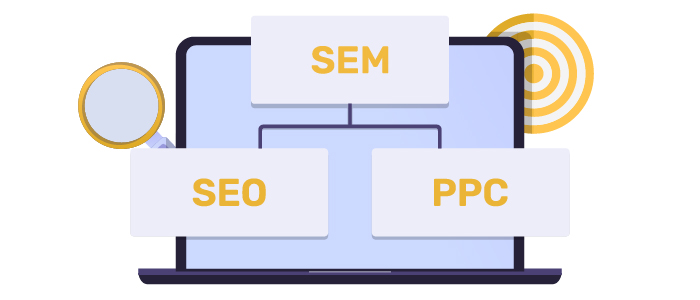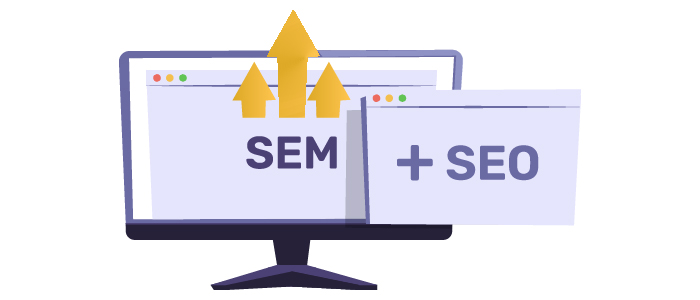What is SEM (Search Engine Marketing)? The importance of SEO and PPC in SEM
Search Engine Marketing, or SEM, originates from the early 2000s and used to be pretty straightforward. Until recently, if you said “SEM,” almost every marketer knew what you meant. But what is SEM today?
However, things have evolved nowadays, and SEM isn’t as clear-cut as it once was.
So, what’s the deal with SEM these days? Why does this shift matter, and what’s in it for you as a marketer? This article is here to break down the changes in SEM and help you grasp the whole picture so you can up your marketing game.
Note: In this article, we’ll frequently refer to Google since it dominates the search engine market with over 90.68% market share and literally dictates what a search engine should be and do.
What is SEM?

First, let’s clarify what SEM is, at least theoretically. So, one of the most precise theoretical definitions of SEM says:
Search Engine Marketing (SEM) represents the process of promoting websites or digital products using BOTH paid and organic advertising strategies in order to drive traffic and visibility through search engine results pages (SERPs) based on a user’s search query.
Basically, it’s an umbrella term used in digital marketing that describes that certain major elements of SEO and PPC fall under the SEM branch.

However, you’re probably inclined to say, “Is this definition respected in practice? If the answer is yes, then why do SEM discussions typically spin around paid advertising in a broader sense? Because when you search for <<SEM>> on Google, you’ll often find definitions and connections primarily linked to paid advertising.”
Well, that’s what we’ll find out in the next section.
The Confusion Around SEM: Is It Just PPC or a Combination of SEO and PPC?

To understand the relation between SEM, SEO, and PPC, let’s use some simple logic with Venn diagrams to clarify:
We have a Venn diagram with three sets that show SEM, SEO, and PPC. In this diagram, we have placed an x in the spaces overlapping Between SEM and SEO, SEM and PPC, and SEM and SEO and PPC. That’s to showcase that SEM has many elements from SEO and PPC tactics. However, there are elements that do not overlap with either SEO or PPC.
Practical industry usage often defines SEM as a set of digital advertising strategies in which you pay to feature your website prominently on search engine result pages (SERPs). Basically, this practical definition largely overlaps with the fundamental concept of internet paid advertising.
And although there are all kinds of definitions from industry giants, we will take Dr. Danny Sullivan’s definition as reference, who serves as both a Google advisor and the co-founder of SearchEngineLand. In one of his articles, he defines SEM as
“A form of internet marketing that seeks to promote websites by increasing their visibility in search engine result pages (SERPs). SEM methods include search engine optimization (SEO), paid placement, contextual advertising, digital asset optimization, and paid inclusion.”
Dr. Sullivan’s perspective (that coincides with many other marketers) represents one of the early interpretations of SEM, Danny Sullivan being also known for making “search engine marketing” popular.
He’s like the founding father of the SEM industry.
So, What’s the Right SEM Definition to Trust and Use?
Our opinion is that Dr. Danny Sullivan’s definition is the best choice to go with.
So, when referring to such a topic, use SEM to include both SEO, PPC, and digital assets (such as Google Business Profile), but be ready for possible misuse and clarify it.
That’s because, in professional discussions, interpretations can vary. For instance, if, in a context, the speaker makes comparisons between SEO and SEM, they are likely referring to SEM as paid ads.
How Does SEM Work and Why It’s Important?
Now that we’ve clarified what SEM really is, are you wondering why it’s important and how it works? If so, we’ll explain here.
Well, you must know that SEM holds a key spot in the digital marketing toolbox for some pretty compelling reasons. It’s a powerful weapon that could help you attract new customers, increase revenue, and give your website a prime seat on the SERP.
Picture it this way: the higher you are on SERP, the more people are likely to find their way to your site, gain insight, make purchases, or engage in other interactions. It helps businesses empower their online presence, pinpoint their target audience, and keep a sharp eye on how well their strategy works.
So, how does SEM work its magic?
Whether a business is all-in on SEO or PPC, both strategies are linked to a fundamental element – keywords. Based on keywords, you can understand what users are actively searching for when they type into a search engine so you can optimize your campaigns.
When a user enters a particular keyword or search term, SEM ensures your brand appears as a result of that query. Yet, achieving a high-ranking position can be accomplished through PPC or SEO methods/strategies.
For instance, consider the keyword “Christmas gifts”:

As you can see, the best companies that rank on that keyword are Click & Grow, BlueGifts, and Alibaba. However, they artificially rank so well because they paid to appear in a leading position on that keyword, using PPC.
So, from this example, remember that advertisers pay for clicks and/or impressions, which can help bring visitors to the website, landing page, social media channels, or products. Simply put, marketers pay or bid for the top space in SERPs on a specific keyword using PPC methods.
This was possible through the following process of participating in an ad auction in Google Ads:
First, they determined two crucial elements: the keywords they wish to bid on and the amount they’re willing to spend per click on that keyword. However, several factors influence the auction outcome, even if the ad aligns well with the chosen keyword.
Generally, Google considers five primary factors during an ad auction:
- Maximum Bid – The highest amount they’ll pay for a click on the ad.
- Quality Score – A score from 1-10 that Google assigns to evaluate the ad’s relevance and usefulness for users.
- Impact of Ad Extensions – Additional information in that ad, such as phone numbers and specific page links.
- Ad Rank – A blend of their bid and the quality of their ad and landing page, with ads required to meet minimum quality thresholds to secure higher positions.
- Ad Context – Google factors in various aspects, including the search term used, user location, search time, device, and more.
Quality Score is a key determinant, as it’s the reason your ad wins auctions for pertinent queries.
However, if they no longer bid on that keyword, the BestProducts and GoodHousekeeping sites would rank in first position on SERP because their articles rank the best from an organic point of view thanks to their SEO strategy.
This was possible because the general quality of their article is better. Getting a better position on Google is all about producing excellent content. So, create well-researched, informative articles that truly help your readers. To grab that top spot, ensure your content covers all aspects of the topic. Include relevant examples, case studies, and stats to make it more credible and engaging for your readers.
Search Engine Marketing Tools
If you’re new to SEM and don’t know where to start, we’ve got you covered with various helpful tools, some of which are free, and others require payment. These tools can significantly improve your experience and results, so you must be aware of their existence:
- Google Ads (free) – Helps you set up and manage paid ad campaigns on Google.
- Google Keyword Planner (free) – Google’s tool for generating keyword ideas.
- Google Trends (free) – Allows you to find trending keywords and analyze keyword trends and seasonality.
- ChatGPT (freemium) – Your SEM content assistant.
- Ahrefs’ Keywords Explorer (paid) – Useful for generating keyword ideas, obtaining more precise keyword data, and analyzing your competitors.
Common Search Engine Marketing Mistakes to Avoid
Search Engine Marketing (SEM) is a crucial part of marketing and advertising for any business. However, it’s important to avoid common mistakes to get the desired results.
In order to avoid them, let’s explore the most common SEM errors that marketers often make so you can steer clear of them.
1. Ignoring Market Research
To create an effective SEM strategy, you must first understand your target audience and what matters to them. Your landing page should speak directly to a specific audience with a compelling message. Here’s what you should do:
- Learn your audience’s language and craft copy that resonates with them.
- Conduct interviews with current customers and prospects to discover what they value about your product or service, their pain points, and how your product addresses them.
- Analyze your competition to see who they are targeting and the language they use.
- Identify what sets you apart from your competitors, whether it’s unique features or exceptional customer support.
2. Ignoring User Intent
User intent refers to what visitors intend to do when they start a search or click a link. Understanding user intent can help you tailor your SEM campaigns effectively. User intent typically falls into three categories:
- Navigational – Users seek to access a specific website.
- Informational – Users are looking for information about a particular subject.
- Transactional – Users are ready to make a purchase.
For example, let’s consider a fictional company, “TechConnect Pro,” a networking solutions provider. If a potential customer searches for “how to improve network security,” their user’s intent is informational. They are seeking knowledge and aren’t ready to make a purchase. In such cases, your landing page should provide informative content.
Now, if the potential customer searches for “best network security provider – TechConnect Pro,” it indicates transactional user intent. They are likely ready to make a purchasing decision. Your landing page, in this instance, should be concise, emphasizing why TechConnect Pro is the best choice, and guide them to take action through a clear Call to Action (CTA).
3. NOT Including SEO in Your SEM Strategy

As discussed in the article, it’s not about pitting SEM against SEO or SEM against PPC. In a well-rounded SEM strategy, SEO and PPC should complement each other.
So, focus on creating timeless content that stays relevant, leverage PPC to achieve rapid traffic, and harness SEO for steady, long-term growth. This way, you won’t depend heavily on PPC in the long run.
Avoid myopic thinking. Combining SEM with SEO can reduce your PPC spending while still achieving your goals.
Conclusion
So, Search Engine Marketing (SEM) is a broad concept that covers various elements and can significantly contribute to the success of any business in search engine results.
However, SEM is more than PPC. More precisely, it has a strong relationship with SEO as well. When you blend these two, you have a killer strategy to up your online game and score big in search engines.
All left for you now is to get to work, so we wish you to be loved by Google and hopefully see you as high up in at least this search engine.